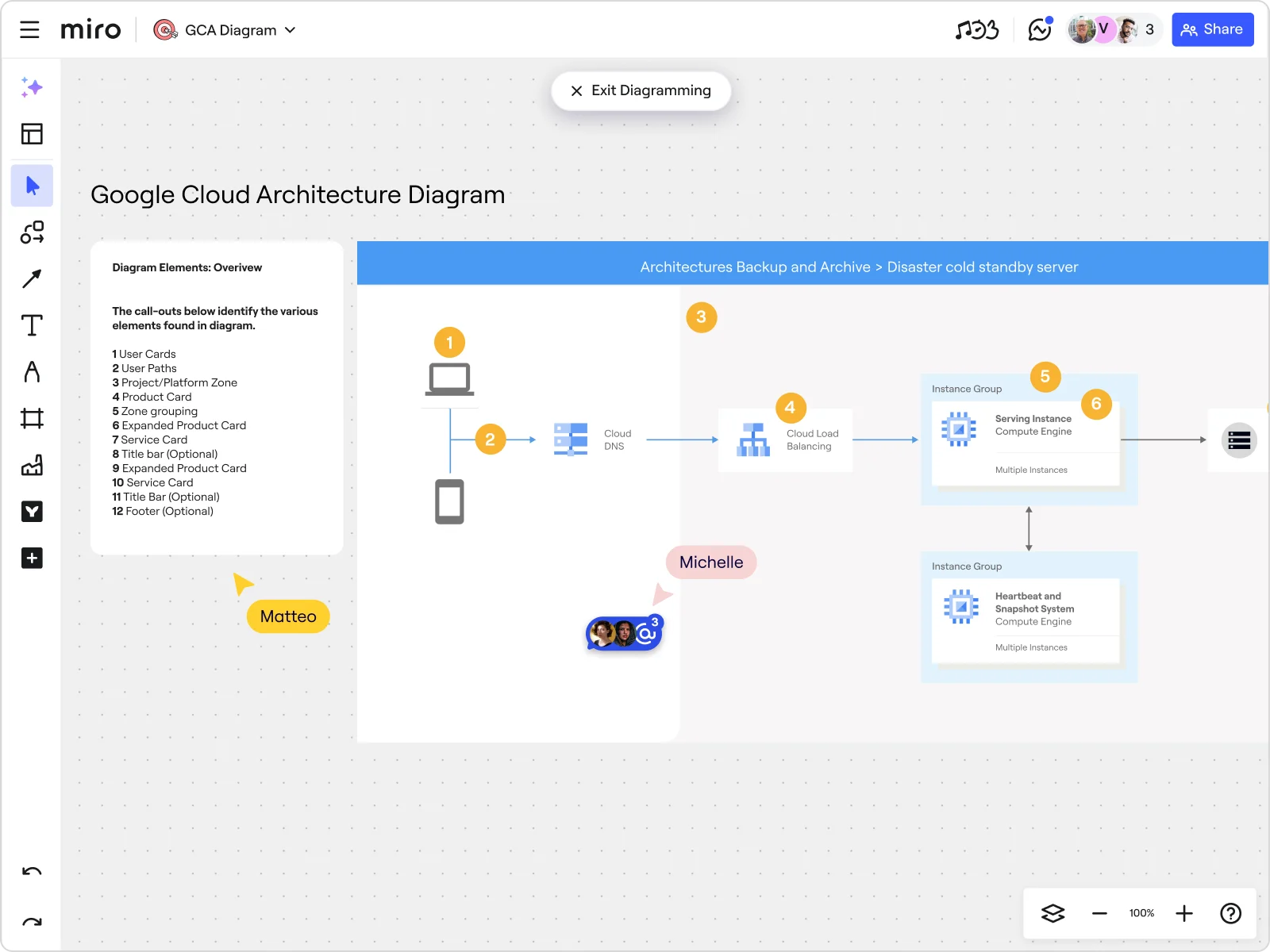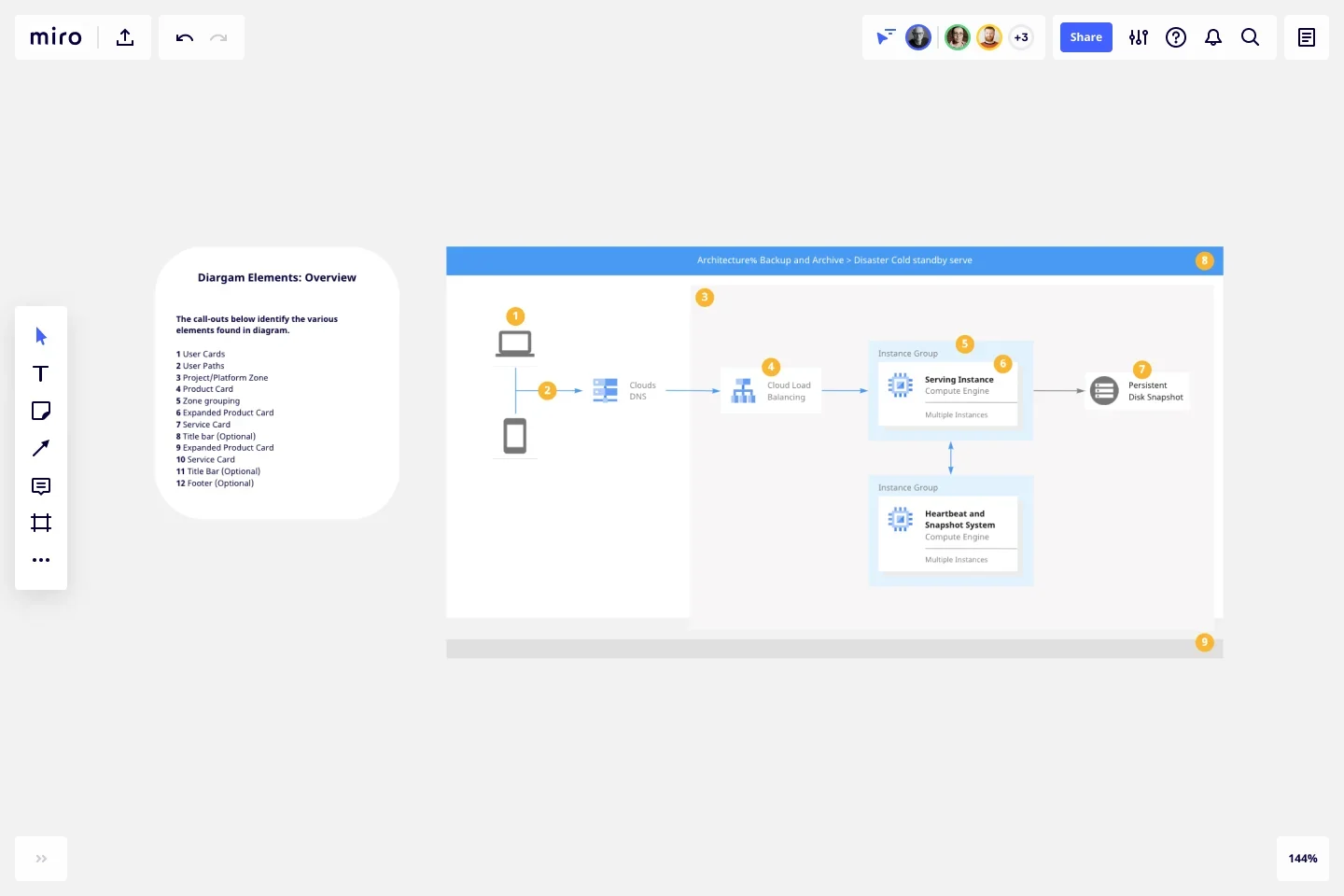
Table of contents
Table of contents
What is Google Cloud Platform (GCP)? Everything you need to know

Summary
In this guide, you will learn:
What GCP is and its role in cloud computing
Main components of GCP (compute, storage, networking)
GCP's infrastructure: regions and zones for reliability
Variety of services: big data, machine learning, developer tools
How GCP services integrate for scalable, secure deployment
Pricing models and free tier options available
Try Miro now
Join thousands of teams using Miro to do their best work yet.
Google Cloud Platform explained
Google Cloud Platform, often referred to as GCP is a suite of cloud computing services provided by Google. But what does that really mean for developers? In essence, GCP offers a lot of tools and services that allow you to build, deploy, and scale applications, websites, and services on the same infrastructure that Google uses for its own products, such as Google Search and YouTube.
Understanding Google Cloud Platform services
Google Cloud Platform offers many services, each catering to different needs and use cases. To give you a clearer picture of what GCP can do, let's break down some of its key services:
Cloud computing
At the core of GCP is its cloud computing service. This includes Google Compute Engine, which provides virtual machines that run on Google’s infrastructure, and Google Kubernetes Engine, a powerful tool for managing containerized applications. These services make it easy to deploy and scale your applications efficiently.
Storage
GCP offers a variety of storage options to suit different needs. Google Cloud Storage is perfect for storing and retrieving any amount of data at any time. For more structured data, Google Cloud SQL and Cloud Spanner offer fully managed relational database services, while Google Bigtable provides a NoSQL database service for large analytical and operational workloads.
Networking
Google’s global network infrastructure ensures high performance and reliability. Google Cloud Load Balancing distributes your workloads across multiple instances, and Cloud CDN accelerates content delivery by caching content close to users. Additionally, Google Cloud Interconnect offers dedicated connections between your on-premises network and Google’s network.
Data analytics
With GCP’s data analytics services, you can turn your data into valuable insights. Google BigQuery is a fully managed data warehouse that allows you to run SQL queries on large datasets quickly. Dataflow offers stream and batch data processing, while Dataproc provides a managed Spark and Hadoop service.
Machine learning
Google Cloud AI and machine learning services make it easy to incorporate AI into your applications. TensorFlow, Google’s open-source machine learning framework, is fully supported on GCP. Google Cloud AI Platform provides a suite of tools for training, deploying, and managing machine learning models, and pre-trained APIs like Vision AI and Natural Language Processing are ready to be integrated into your applications.
Productivity and collaboration
GCP isn’t just about infrastructure and data; it also enhances productivity and collaboration. Google Workspace (formerly G Suite) offers a range of tools like Gmail, Google Drive, and Google Meet, making it easy for teams to collaborate and stay productive.
Benefits of using the GCP
Google Cloud Platform comes with many benefits that can significantly enhance your development projects. These benefits range from scalability and security to cost efficiency and seamless integration with other Google services. Let's explore these advantages in detail.
Scalability
One of the most compelling reasons to use GCP is its unmatched scalability. Whether you're starting with a small app or running a global service, GCP's infrastructure can handle it. With autoscaling features, your application can automatically adjust resources based on traffic and demand, ensuring optimal performance without over-provisioning.
Robust security
Security is a top priority for any developer, and GCP excels in this area. GCP offers a comprehensive set of security features, including Identity and Access Management (IAM), Virtual Private Cloud (VPC), and encryption by default. These tools help protect your data and applications from threats, giving you peace of mind.
Powerful data analytics
In today's data-driven world, being able to analyze and draw insights from your data is crucial. GCP provides powerful data analytics tools like BigQuery, a fully managed data warehouse that allows you to run fast SQL queries on large datasets. With Dataflow and Dataproc, you can process and analyze data in real-time, gaining insights that drive business decisions.
Global network infrastructure
GCP's global network infrastructure ensures that your applications have low latency and high performance, no matter where your users are located. Google’s extensive network, including fiber optic cables and edge caching, delivers your content quickly and reliably, enhancing the user experience.
Cost efficiency
Managing costs is always a concern, and GCP provides tools to help you optimize your spending. With pay-as-you-go pricing, you only pay for the resources you use. GCP also offers sustained use discounts, committed use contracts, and cost management tools to help you monitor and control your expenses.
Integration with Google services
As part of the Google ecosystem, GCP integrates seamlessly with other Google services like Google Workspace, enhancing productivity and collaboration. This integration allows for easy data sharing and collaboration across your team, streamlining workflows and improving efficiency.
How to create your GCP architecture diagrams in Miro

Creating detailed and accurate Google Cloud architecture diagrams is essential for visualizing your cloud infrastructure. Here is a step-by-step on how to do it in Miro:
Start with a template: Use the pre-made Google Cloud architecture diagram templates available in Miro. This provides a structured starting point and can save time.
Use shape packs: Miro has a Google Cloud Platform (GCP) shape pack that contains all the necessary icons and elements for Google Cloud components. You can find these in the shape library.
Drag and drop elements: Use the intuitive drag-and-drop interface to place and arrange the elements on your diagram.
Customize with Icons: Integrate additional icons from external libraries like Iconfinder and Unsplash to enhance your diagram visually.
Collaborate in real-time: Use Miro’s collaboration tools to work with team members in real time on the diagram, allowing for immediate feedback and iterative design.
Export and share: Once your diagram is complete, export it in various formats such as images, PDF, CSV, or .RTB files to share with stakeholders or include in presentations.
GCP architecture diagram examples
Creating GCP architecture diagrams can help you visualize and plan your cloud infrastructure effectively. Here are a few examples of common GCP architecture diagrams that you can create using Miro’s visual workspace:
Web application architecture
A typical web application architecture on GCP includes various components like Google Compute Engine for hosting the web server, Cloud Storage for static content, Cloud SQL for the database, and Cloud Load Balancing for distributing traffic. A diagram for this setup would detail how these components interact to deliver a robust web application.
Microservices architecture
Microservices architecture on GCP often involves Google Kubernetes Engine (GKE) for container orchestration, Pub/Sub for messaging between services, Cloud SQL or Firestore for databases, and Cloud Monitoring for observability. This diagram helps in understanding the deployment of multiple microservices and their communication pathways.
Data processing pipeline
For data-intensive applications, a data processing pipeline diagram might include Dataflow for data ingestion and processing, BigQuery for data analysis, Cloud Storage for data staging, and AI Platform for machine learning model deployment. This architecture showcases how data moves and transforms through various stages in GCP.
Hybrid cloud architecture
In a hybrid cloud architecture, you might integrate on-premises infrastructure with GCP services. This could include using Google Cloud Interconnect to connect your on-premises network with GCP, Compute Engine instances for additional compute power, and Cloud Storage for scalable storage. The diagram would illustrate how resources are managed and utilized across both environments.
IoT architecture
An IoT architecture on GCP might involve Cloud IoT Core for device management, Pub/Sub for message ingestion, Dataflow for real-time processing, Bigtable for storing time-series data, and BigQuery for analytics. This setup demonstrates the flow of data from IoT devices to cloud services and analytics platforms.
These examples highlight GCP's versatility and capability in supporting various application architectures. Using Miro’s templates and tools, you can easily create and share these diagrams, ensuring clear communication and effective planning for your cloud projects.
GCP best practices
To get the most out of Google Cloud Platform, following best practices is essential. These guidelines will help you design scalable, secure, and cost-effective applications while leveraging GCP’s powerful features. Here’s a detailed look at each best practice:
Design for scalability
When designing your applications on GCP, it’s crucial to plan for scalability. Use GCP’s managed services and autoscaling features to ensure your applications can handle varying loads. This approach not only improves performance but also helps manage costs by scaling resources up or down based on demand. Leverage services like Google Kubernetes Engine for containerized applications and Google Compute Engine’s autoscaling capabilities to maintain optimal performance.
Implement strong security measures
Security should be a cornerstone of your GCP strategy. Take advantage of GCP’s robust security features, such as Identity and Access Management (IAM), which allows you to control who can access your resources. Use Virtual Private Cloud (VPC) for network isolation and implement encryption for data at rest and in transit. Regularly review and update your security policies to adapt to evolving threats.
Optimize costs
Cost optimization is essential for maximizing the value of GCP. Regularly review your resource usage and take advantage of GCP’s cost management tools, such as the Google Cloud Pricing Calculator and Billing Reports. Implement resource quotas to avoid overspending and explore options like committed use contracts for predictable workloads to benefit from significant discounts.
Leverage data analytics
GCP’s data analytics services can transform your raw data into actionable insights. Use BigQuery for fast, SQL-based analysis of large datasets, and integrate Dataflow for stream and batch data processing. By leveraging these tools, you can gain deeper insights into your operations, customer behavior, and market trends, driving informed business decisions and enhancing your competitive edge.
Automate with DevOps tools
Integrate GCP’s DevOps tools to automate your CI/CD pipelines and monitor your applications effectively. Use Cloud Build for continuous integration and delivery, and Stackdriver for monitoring and logging. Automating these processes not only increases efficiency but also reduces the risk of human error, ensuring that your deployments are reliable and consistent.
Why Miro is the best tool for diagramming your GCP architecture
When working with cloud computing, it is essential to have the right tools for visualizing and collaborating on your cloud architecture. Miro is the top choice for a GCP architecture diagram tool because of its comprehensive features and user-friendly interface. With pre-made templates, specialized shape packs, and robust collaboration tools, Miro simplifies the process of creating detailed and accurate architecture diagrams.
For developers working within product teams, Miro provides an innovation workspace that enhances productivity, facilitates collaboration, and ensures your GCP architecture diagrams are both precise and professional. Embrace Miro for your Google Cloud architecture diagramming needs and experience a seamless, efficient, and collaborative workflow.
Author: Miro Team
Last update: October 14, 2025